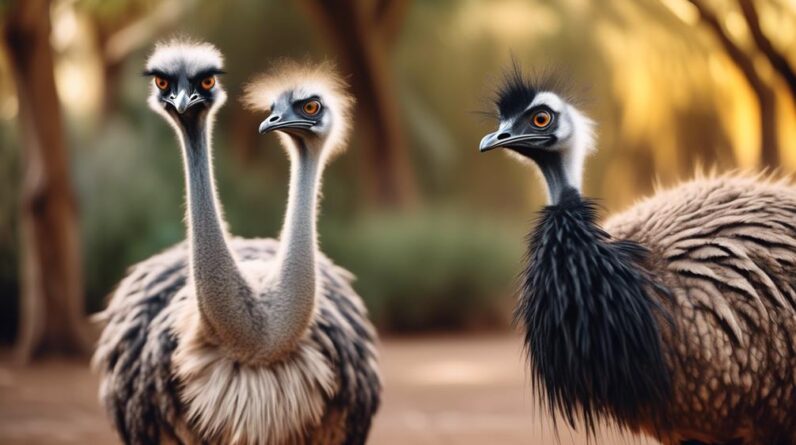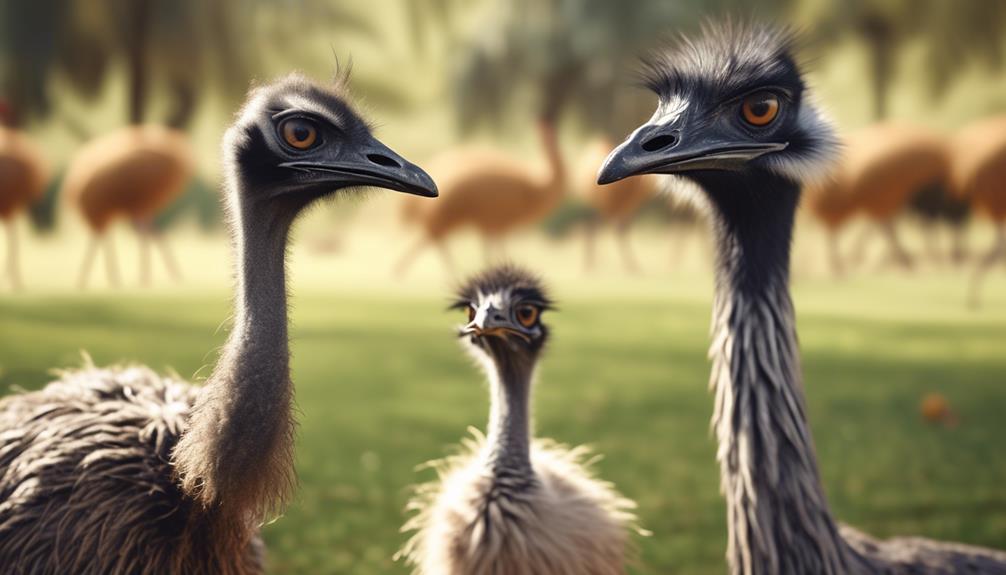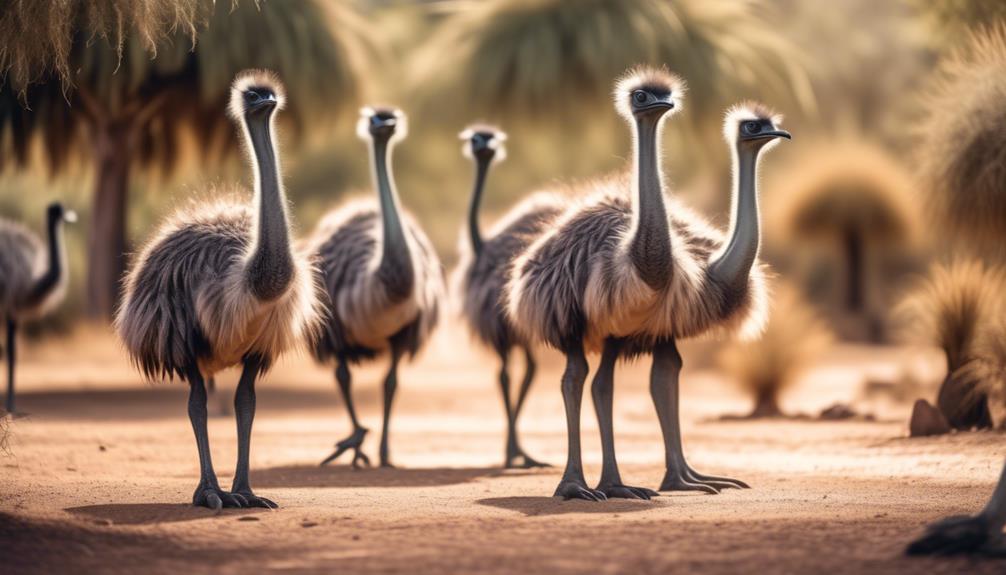
They say birds of a feather flock together, but when it comes to emus and rheas, it's not always easy to tell them apart. These flightless birds may share some similarities, but they also have key differences that set them apart.
From their physical appearance to their behavior and social structure, understanding the nuances between these two fascinating creatures can shed light on the diversity of the avian world.
So, buckle up, because we're about to embark on a journey through the world of emus and rheas, uncovering the secrets that make them unique.
Are you ready to discover what sets these birds apart?
Physical Appearance

Emus and rheas possess distinct physical characteristics that allow for easy differentiation between the two species. One key difference lies in their plumage color. Emus have predominantly brown feathers, while rheas have a mix of gray, black, and white feathers. This variation in coloration is an important visual cue for distinguishing between the two species.
Another noticeable difference between emus and rheas is their size. Emus are the larger of the two, standing at an impressive height of up to six feet and weighing around 100 pounds. In contrast, rheas are slightly smaller, reaching heights of around four to five feet and weighing approximately 50 to 70 pounds. This significant size difference is evident when observing the two species side by side.
These distinct physical characteristics make it relatively easy to identify whether you're looking at an emu or a rhea. By paying attention to the plumage color and comparing the size of the bird, you can confidently differentiate between these fascinating flightless birds.
Habitat and Distribution
The habitat and distribution of rheas is influenced by a variety of factors, including their preferred ecosystems and geographical range. Rheas, being native to South America, have a wide geographic range that spans across Argentina, Brazil, Uruguay, and Paraguay. They're primarily found in grasslands, savannas, and scrublands, but can also be seen in forests and wetlands. Rheas have adapted to various environmental conditions, allowing them to thrive in different habitats.
Their environmental requirements include:
- Open Spaces: Rheas prefer habitats with extensive open spaces, as they're flightless birds and rely on their running abilities to escape predators. They need enough space to move around and forage for food.
- Adequate Vegetation: Although rheas inhabit open areas, they require a good amount of vegetation for feeding and nesting. They feed on plants, seeds, fruits, and small invertebrates, and therefore need access to a diverse range of vegetation.
- Water Sources: While rheas can survive in relatively dry habitats, they still require access to water sources for drinking and bathing. They're known to frequent rivers, ponds, and marshes.
Understanding the habitat and distribution of rheas helps us appreciate their adaptation to different environments and highlights the importance of preserving their natural habitats for their continued survival.
Feeding Habits

Rheas exhibit a diverse array of feeding habits, which play a crucial role in their survival and reproductive success. These flightless birds have specific feeding preferences and dietary needs that are essential for their overall health and well-being.
To gain a deeper understanding of the feeding habits of rheas, let's take a look at the following table:
| Feeding Preference | Dietary Needs | Example Food Sources |
|---|---|---|
| Herbivorous | High-fiber plant material | Grasses, leaves, fruits |
| Omnivorous | Plant material and small prey | Insects, seeds, small vertebrates |
| Opportunistic | Varied diet | Carrion, reptiles, eggs |
| Seasonal | Dependent on availability | Berries, nuts, aquatic plants |
As herbivores, rheas primarily consume high-fiber plant material such as grasses, leaves, and fruits. However, they can also exhibit opportunistic feeding behavior, consuming carrion, reptiles, and even eggs when available. Their dietary needs may also vary seasonally, with rheas adapting to the availability of berries, nuts, and aquatic plants during certain times of the year.
Understanding the feeding preferences and dietary needs of rheas is crucial for their conservation and management in their natural habitats. By ensuring a balanced and varied diet, we can contribute to the overall health and well-being of these fascinating birds.
Reproduction and Offspring
After exploring the feeding habits of rheas, it's important to examine their reproductive behaviors and the characteristics of their offspring.
Rheas have developed several reproductive adaptations that contribute to their successful breeding. Firstly, they engage in a polygamous mating system, where males compete for the attention of females. During courtship, males perform elaborate displays, such as puffing their feathers and emitting low-frequency vocalizations, to attract a mate.
Once the female selects a mate, she'll lay her eggs in a communal nest that's shared with other females. This behavior is known as polygynandry, where multiple males and females contribute to the same nest. This provides protection and allows for efficient incubation of the eggs.
Rheas exhibit remarkable parental care. After the eggs are laid, the male takes on the primary responsibility of incubating them for approximately 40 to 45 days. The males are highly vigilant during this period, protecting the eggs from predators and regulating the temperature by adjusting the nest.
Once the chicks hatch, they're precocial, meaning they're capable of independent movement shortly after birth. However, the male continues to provide care and protection until the chicks are fully independent.
Behavior and Social Structure

To understand the behavior and social structure of rheas, it's crucial to examine their interactions and social dynamics within their natural habitats. Rheas, like emus, are social birds that live in groups called flocks. These flocks can consist of up to 30 individuals, with a hierarchical organization based on dominance and submission.
Communication patterns play a vital role in the social structure of rheas. They use a variety of vocalizations to communicate with one another, including low frequency booms, whistles, and hisses. These vocalizations are used for various purposes, such as maintaining group cohesion, warning others of potential threats, and attracting mates.
Within the flock, there's a clear hierarchical organization. Dominant individuals establish their authority through displays of aggression, such as threatening postures and vocalizations. They've priority access to resources, such as food and nesting sites. Subordinate individuals, on the other hand, exhibit submissive behaviors, such as avoiding eye contact and yielding to dominant individuals.
However, it's important to note that the social structure of rheas can vary depending on factors such as food availability and breeding season. During the breeding season, males establish territories and engage in elaborate courtship displays to attract females.
Conservation Status
In order to fully understand and address the conservation status of these fascinating birds, it's essential to examine the factors that contribute to their population decline and the measures being taken to protect them.
The emu and the rhea are both classified as endangered species, with their populations experiencing significant declines in recent years. Several factors contribute to this decline, including habitat loss due to human activities such as deforestation and agricultural expansion. Additionally, both birds face threats from hunting and predation by introduced species.
To protect these magnificent creatures and ensure their survival, conservation efforts are underway. Here are some measures being taken:
- Establishing protected areas: Governments and conservation organizations are working to establish protected areas where the birds can thrive without human interference.
- Conservation breeding programs: Breeding programs are being implemented to increase the populations of both emus and rheas in captivity, with the goal of reintroducing them into their natural habitats.
- Public awareness campaigns: Educating the public about the importance of these birds and the need for their conservation is crucial in garnering support and promoting responsible actions.
It is imperative that we continue to support these conservation initiatives to prevent further population decline and ensure the long-term survival of these remarkable species.
Frequently Asked Questions
How Fast Can Emus and Rheas Run?
Emus and rheas are both known for their impressive running speeds. Emus can reach speeds of up to 31 miles per hour, while rheas can reach speeds of up to 40 miles per hour.
What Are the Main Predators of Emus and Rheas?
Predation rates and adaptations for survival are crucial for both emus and rheas. Understanding their main predators is key. Emus face threats from dingoes and eagles, while rheas contend with jaguars and foxes.
Are Emus and Rheas Capable of Flying?
Emus and rheas both possess physical differences that affect their flight capabilities. Emus have smaller wings and are flightless, while rheas have larger wings and can fly short distances.
Do Emus and Rheas Migrate?
Emus and rheas have different migratory patterns and breeding habits. Emus are non-migratory, while rheas are known to migrate. Emus breed throughout the year, while rheas have a specific breeding season.
Are Emus and Rheas Kept as Pets?
Yes, emus and rheas can be kept as pets. Emus are sometimes used as therapy animals due to their calm nature, while rheas are often farmed and commercially used for their meat, feathers, and leather.
Conclusion
In conclusion, the emu and rhea exhibit distinct differences in their physical appearance, habitat, feeding habits, reproduction, and behavior.
While the emu is characterized by its tall stature and brown feathers, the rhea possesses a smaller frame and gray plumage.
Emus are native to Australia, while rheas are found in South America.
These disparities in their characteristics and habitats contribute to their unique behaviors and social structures.
Understanding these dissimilarities is crucial for effective conservation efforts of these remarkable flightless birds.





